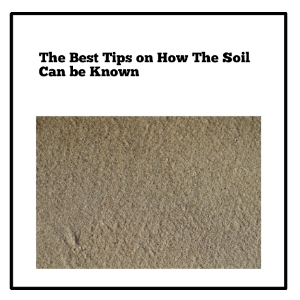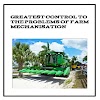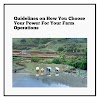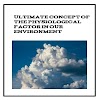Soil is defined as the uppermost layer of the earth's crust which provides support and nutrients for the growth of plants.
There are three main types of soil which includes Sandy soil, clay soil, and loamy soil.
Sandy soil
A soil is said to be sandy if the proportion of sand particles in a sample of soil is very high. The particles are mainly quartz and they have the size ranging from 0.02mm to 2.00mm in diameter.
Properties of Sandy Soil
1. Sandy soil is coarse, grained, and gritty in nature.
2. Sandy soil absorbs water and loose it quickly.
3. Percolation is high in sandy soil and capillarity is low.
4. It doesn't support waterlogging ans erosion since water can stay in it.
5. Sandy soil is greyish and brownish in colours
6. This sand support leaching.For this reason, it is low in plant nutrients.
7. Sandy soil is not sticky, when wet since it contains big sand particles.Hence, it cannot form a cast or ribbon.
8. This soil is well aerated with low water holding capacity.
Methods of Improving Sandy Soil
Sandy soil can however be improved through the following agricultural practices .
1. Mulching of soil: Mulching sandy soil prevent it from loosing water through evaporation and nutrients loss by water erosion.
2. Avoidance of bush burning: Bush burning promotes soil erosion,kills soil organisms and removes organic matter which can contribute to the fertility of the soil.
3. Application of farm yard manure: Applying manure to sandy soil will improve the soil structure and also add nutrients to the soil.
4. Planting cover crops: Cover crops helps provides shade, prevent erosion snd add more nutrients to the soil.
5. Application of compost manure: Compost manure helps to bind the sand particles together and also add humus (nutrients) to the soil.
Economic Importance of Sandy Soil
(i) Sandy soil is very good to plant crops like cottons, groundnut, cassava etc.
(ii) It is also useful in building construction and for moulding blocks with cements and water.
Clay Soil
A soil is said to be clayey if the proportion of clay in a sample of the soil is very high. The relative saze of a call particles is less that 0.002 mm in diameter. It is a heavy types of soil because it is difficult to work on and cultivate.
Properties of Clay Soil
1. Clay Soil is always powdery, fine and smooth when it dried.
2. The particles are always sticky and mouldy when it's wet.
3. The particles of clay soil is relatively tightly bound together with a little more spaces between.
4. The capillarity in clay soil is very high and percolation is low.
5. This soil support waterlogging and erosion because of the little space between them.
6. It has grey or brownish color.
7. It doesn't support leaching. Hence, it contains plant nutrients.
8. The soil is poorly aerated with high water holding capacity.
9. This soil is very hard when dry ans sticky when wet.
Note : Clay Soil can be improved through:
(i) Liming
(ii) Addition of organic manure.
Loamy Soil
Loamy soil is a mixture of Sandy and clay soil particles with a great proportion of organic matter.Loamy soil is the most fertile soil and the best for agriculture.
Properties of Loamy Soil
1. Loamy Soil is moist, loose with moderate sized pore spaces.
2. It is well aerated and can hold water.
3. Loamy soil doesn't support waterlogging and erosion.
4. This type of soil is dark brown and black in colour.
5. It contains plants nutrients , hence, it is the best for the cultivation of crops like maize, rice , yam, cassava, tomatoes, okra, pepper, millet etc.
6. The structure breaks easily when wet ans friable when dry.
7. Loamy Soil can easily be worked on or cultivated.
8. It contains alot of organic matters.
9. It has non-powdery ams non sticky texture.
Formation of Soil
Soil formation is greatly controlled by five major factors which are:
1. Climate : Elements of climate such as rainfall, temperature ,wind and pressure are very all important in soil formation.
2. Parental Materials: Parent materials constitutes the major materials from which soil is formed.They are igneous, sedimentary, and metamorphic rocks.
3. Topography: The shape of the group in relation to the rock under of the earth is known as topography.Topography affects the rate of run-off and erosion.
4. Biotic Factors: The activities of living organisms helps to speed up the formation of soil. Termites , earthworm etc mix the mineral and organic matter together , and this result in the formation of soil. Microbes help in the decomposition of organic matter in the soil. The decay of fallen leaves from the trees with the aid of bacteria results in the formation of humus, and this is rich plants of foods.
5. Time: Time plays am important role in the soil formation.It takes a long time for mature soil to be formed.It takes a long time for a small pieces of rock to disintegrate into grains of soil.It takes a long time for plants to decay and becomes part of the soil.
Process of Soil Formation
The process of soil formation is known as weathering. Weathering bus defined as the disintegration of rocks into tiny particles to form soil.It is the breaking down of rock masses into simpler forms through the agents of physical, chemicals and biological processes.
The process of soil formation includes;
1. Physical Process: The agent of physical weathering are temperature for heating and cooling of the rocks, winds for grinding of rocks, ice for increasing the volume result in more pressure being exerted to breaks and water from breaking rocks into pieces.
2. Chemical Process: Agents of chemicals weathering includes solutions for dissolving soluble minerals present in rocks, carbonation when carbon dioxide mixes with rain water to form weak carbonic acid that dissolves rocks, oxidation, hydrolysis, and hydration.
3. Biological Process: This involves the breaking down of rocks feom the activities of plants and animals to form soil.The activities of man during farm operation such as ploughing and harrowing also breaks down rocks into tiny pieces.
Composition of Soil
The soil is made up of five components which are:
1. Organic matter
2. Soil Air
3. Living Organisms
4. Soil Water
5. Inorganic Matters










0 Comments